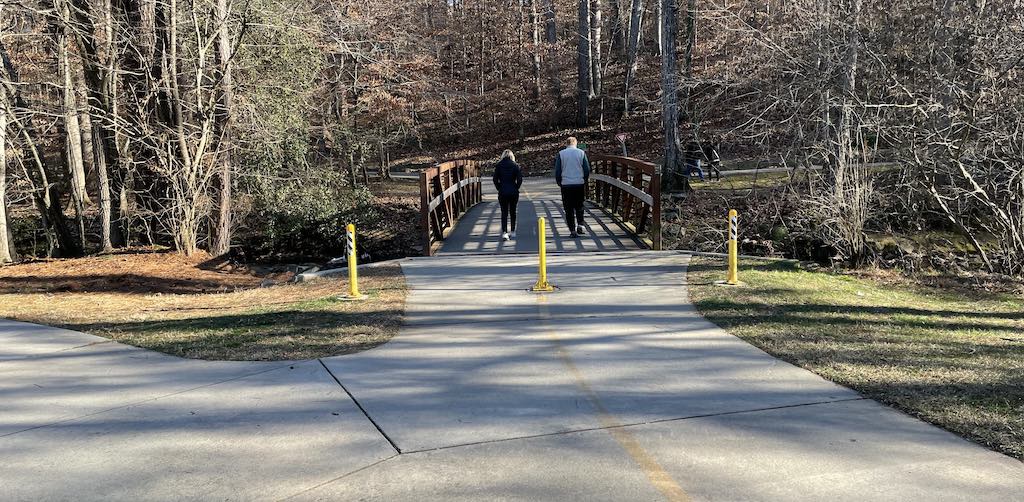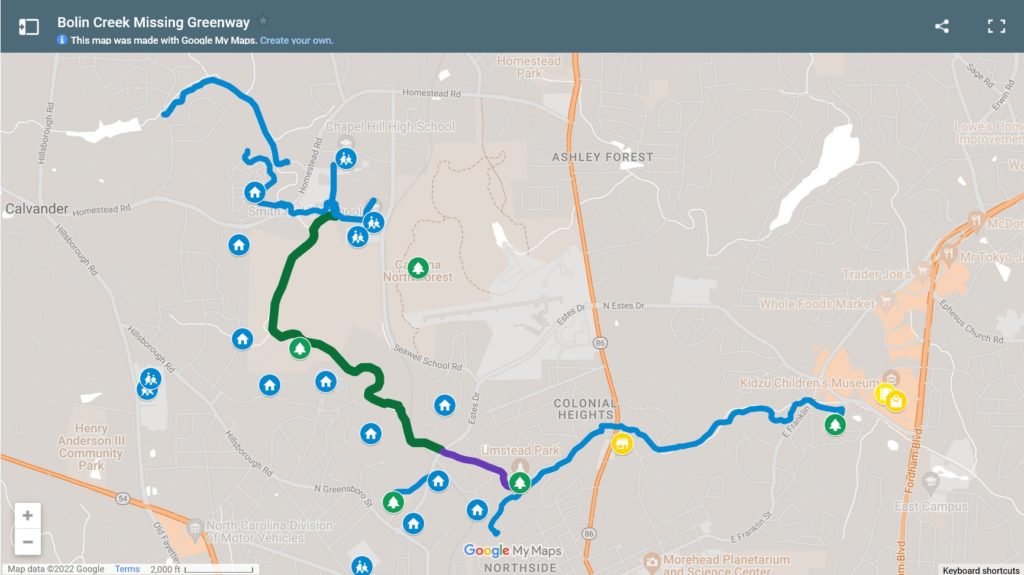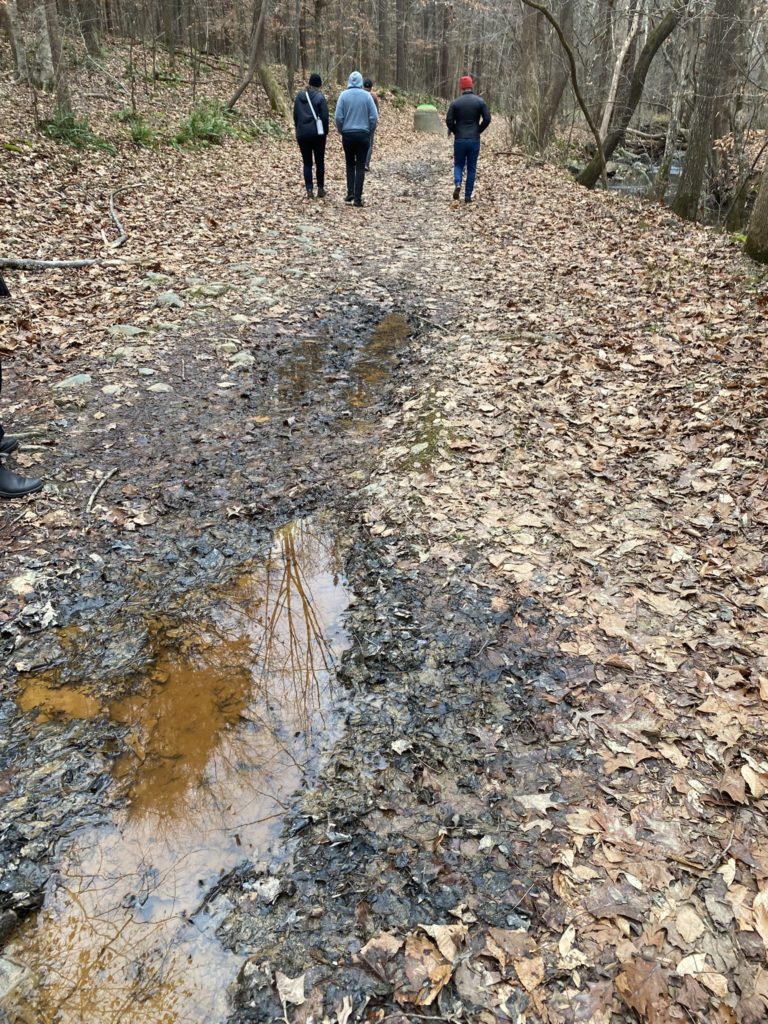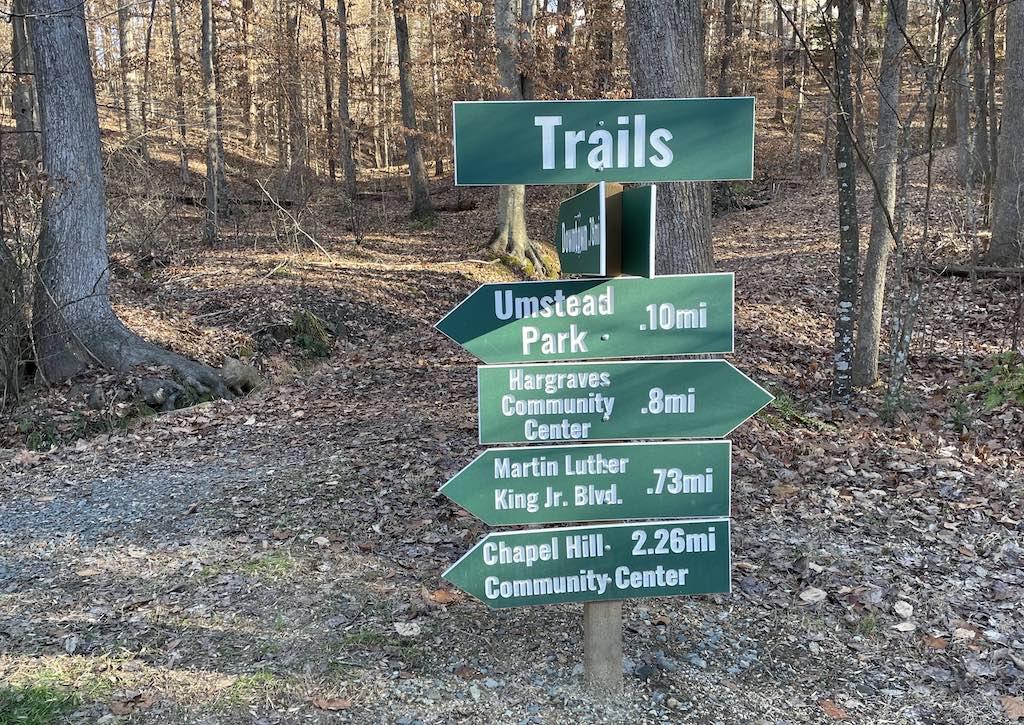Related: Learn more about Carrboro’s Linear Park Project and sign up for updates to build out Carrboro’s greenway network.
My family lives within walking distance of Carrboro’s Bolin Creek, but we frequently drive to Umstead Park in Chapel Hill to walk along Bolin Creek’s paved path.

With the envisioned paved Bolin Creek Greenway in Carrboro (and the extension of the Bolin Creek Greenway in Chapel Hill) we would be able to go all the way from our home, on foot or bike, to Umstead Park, Cafe Driade, Smith Middle School, the Chapel Hill Public Library, and the Community Center. My kids would be able to bike to middle school and high school safely — something that with our current bus issue, would solve a lot of morning juggling.

Extending the greenway in Carrboro along the existing 30-foot-wide cleared sewage easement would be transformative for my family and for the many families in my neighborhood — many of us currently drive for 1-3 mile trips when we’d much rather walk, bike, ride, or stroller along the creek. (The creek path gets super muddy after rains and there are a ton of roots and holes that are tough to navigate.)

If you didn’t live here a decade ago, you might not know that a small group of anti-greenway people have been trying to block Carrboro’s greenway (which would extend the existing Chapel Hill greenway along Bolin Creek’s sewage easement) for much of the past decade.
In recent weeks, we’ve started to see them post a lot of misleading facts and misinformation about the project on social media, in newsletters, and over email lists. We’re going to start debunking these statements.
One of the things they say is:
We must do XX before we can consider the Bolin Creek Greenway.
XX changes. One of their latest talking points is that we must construct a bike path along Sewell School Road before we can begin to tackle the Bolin Creek Greenway conversation.
Seawell School Road is a narrow, two-lane road with no sidewalks for most of the long stretch between Seawell School Road and Estes Drive Extension. It lacks a paved shoulder, much less sidewalks or any multi-use path. The proposed route crosses the still-active 4.91-mile long railroad track. Along with the safety issues that poses, there are massive coordination challenges in building bicycle and pedestrian facilities across active railroad tracks. An analysis by a graduate student at UNC in 2020 notes that “rail-to-trail construction is not currently feasible due to ongoing freight operations.”
The Sewell School Road path would be useful for folks who live along Homestead, but it won’t help anyone who lives along Greensboro in Carrboro. And it truly feels that this is the worst kind of road, one that feels like a rural stretch of highway but is in fact rather busy, particularly during school hours.
None of us, even the bikers, would let our kids use it.
A paved path through the woods, on the other hand, would allow kids from all over Carrboro and Chapel Hill to get to middle school and high school safely and without worrying about traffic. That would save car trips, time, and worry for parents all across town.
Let’s look at Chapel Hill’s greenway
We’re also starting to see opponents to Carrboro’s greenway state claims (about topography, engineering, design, etc) as absolute fact, when they actually would need to be determined through further design and engineering work.
The Bolin Creek Greenway Conceptual Master Plan was written in 2009, and it’s a **conceptual** plan. That means it talks about opportunities and proposed possibilities — but actual implementation would need to be determined through later field work, design, and engineering.
This is how a lot of civic projects work — the conceptual phase gets all ducks lined up in a row, and other assessments follow.
The Bolin Creek Greenway Conceptual Master Plan report acknowledges that ecological, erosion, etc issues would need to be understood better through the process of design and engineering. There are many examples of how to build greenways in more difficult terrain, including right next door in Chapel Hill — and in Hillsborough, Durham, Raleigh and hundreds of locations across the country.
Other claims are made about animals. We spoke to a wildlife ecologist who noted “not even the most sensitive interior forest species would be impacted by paving the trail.” That’s because we’re talking about converting an existing, heavily-trafficked trail that exists next to a highly altered urban stream whose watershed consists of A LOT of impervious surface.
And building the trail doesn’t mean harming the creek. (There have been no changes in the EPA’s assessment of water quality in the Chapel Hill section of the creek since the paved trail was built.) Here is a stream restoration expert talking about Bolin Creek in Chapel Hill and how building the paved greenway was beneficial for the creek.
Fact: The existing unpaved trails won’t go away
Other claims they make aren’t relevant. For example, they talk about the non-paved trails that mountain bikers and hikers use as if they would go away. These mountain biking trails wouldn’t change at all. The paved path would follow the creek along an existing sewer easement, not go through the forest or destroy existing mountain biking routes.
It’s also true that some people enjoy the entire area as it exists right now. Those people are able-bodied. The current Bolin Creek Trail in Carrboro is not accessible to people in wheelchairs or strollers or those with limited mobility. (The Bolin Creek Trail in Chapel Hill is heavily used by pedestrians and people of all ages and mobility levels.)
When we pointed this out, an anti-greenway advocate responded by saying “My own children have walked the unpaved trail since they were 2 years old. Children don’t require a paved surface to walk.”
We know people of all ages who have never been creekside in Carrboro because they’re not able to physically get around the knotted roots and deep puddles that currently exist and make it difficult, if not impossible, to traverse if mobility issues exist. Not to mention the fact that the easement in its current state is rendered unusable for anyone whenever we get significant amounts of rain.
As our community ages and shifts in demographics, ensuring that there are safe, paved spaces to be near nature is really important — for both kids and grownups. Right now, strollers and wheelchairs can’t go on the Bolin Creek Trail in Carrboro, but they can on the paved path right next door in Chapel Hill.
Fact: An extensive public engagement process has already taken place
They are now calling for a lengthy public engagement process to decide what happens next. Of course, discussions need to take place, but a lengthy public engagement process has already taken place for this proposed greenway. In May and June of 2009, the consultant that produced the Bolin Creek Greenway Conceptual Plan held community input workshops where citizens filled out comment cards and annotated maps to discuss the pros and cons of different trail alignments. The input from these sessions was incorporated into the approved plan. In addition, there have been many meetings, calls for public input, and discussions around this greenway.
Over the past decade, Town Council in Carrboro has heard every argument, for and against, the greenways. We encourage the town to ensure that this process is fair, moves forward, and relies on experts who don’t have their backyards next to Bolin Creek.

